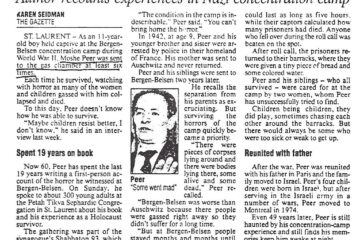Holocaust Insights 2: Bergen-Belsen
THIS SERIES is based on the new Holocaust Encyclopedia by Germar Rudolf (available from Cosmotheist Books; please buy it here to support our efforts!), a massive volume (634 pages) that demolishes once and for all the myths, misunderstandings, exaggerations, and outright fabrications that surround the “Holocaust” story. We now present the section dealing with the much-lied-about Bergen-Belsen concentration camp from this highly readable and professionally produced reference work.
Documented History
The Bergen-Belsen Camp started out in the 1930s as a construction worker’s camp for a nearby military training ground of the German armed forces. After World War Two broke out, the camp was repurposed and expanded as a PoW camp. In April 1943, several sections of this camp were taken over by the SS and served as a holding camp for Jews waiting for an exchange with German PoWs held by Allied forces. In early 1944, it became a hospital/rehab camp. In August 1944, a section was converted to a women’s camp, which became noticeable during the British Bergen-Belsen Trial, where a considerable portion of the witnesses were former female camp inmates.
During the second half of 1944, with the beginning of evacuations of camps being overrun by advancing Allied forces, Bergen-Belsen started receiving an increasing number of inmates from other concentration camps. Overcrowding of the camp became catastrophic by the end of 1944. Around the same time, any supply of food, water, medicine, and coke (for heating, cooking and cremations) became first unreliable, then ceased altogether as a result of Allied bombing.
A review of the camp’s supply situation by a British medical student sent to Bergen-Belsen after its occupation by British forces revealed that the situation for the inmates was relatively good until late 1944, when it started deteriorating, first slowly, then catastrophically by the end of 1944.
As a result, all inmates starved, clean drinking water was no longer available, dirty well water led to dysentery and typhoid fever, lack of means to disinfest and wash closes and inmate housings led to the spread of fleas and lice, causing a typhus epidemic to break out. Any pharmaceutical or other means to provide medical treatment ran out. Inmates started dying rapidly, and so did the guards and SS men. Due to a lack of fuel, cremations could no longer be carried out, although the camp’s one existing furnace would have been unable to cope with the thousands of inmates that were dying every week starting in February 1945, even if there had been enough fuel.
When British troops entered the camp on 15 April 1945, peacefully handed over by the Germans, they found an infernal scene. The campgrounds were littered with thousands of dead and dying inmates. The British Political Warfare Executive took advantage of this opportunity by recording these scenes, including the subsequent burial of thousands of deceased inmates in mass graves. Some bodies were hand-carried by SS men and women who had stayed behind, and were now forced by the British to clean up the mess, while other bodies were pushed into mass graves by bulldozers brought by the British.
(For details, see Stiftung Niedersächsische… 2010; Weber 1995a; Barton 1975; Kulaszka 2019, pp. 195-200.)
Propaganda History
The horrific scenes of a camp littered with emaciated dead and dying inmates, of hundreds, even thousands of victims thrown and pushed into mass graves, were integrated into Allied propaganda “documentaries.” These were meant to prove to the world, and most importantly to “re-educated” Germans, the diabolical nature of National Socialism. Movies such as the U.S. PsyOps documentary Death Mills and Alfred Hitchcock’s Memory of the Camps, which misrepresent these veritable mountains of corpses as the result of a deliberate National Socialist policy of extermination, are powerful tools of shock-and-awe social engineering to this very day, exactly because of the scenes recorded at Bergen-Belsen.
As a result, Bergen-Belsen misleadingly received the designation “death camp” by the Allies (e.g. in Nuremberg Document 036-USSR, IMT, Vol. 39, p. 277), which some took as a hint to push this propaganda envelope even further. For example, U.S. historian Francis Miller wrote in his 1945 History of World War II on page 868:
“In Belsen, [camp commandant] Kramer kept an orchestra to play him Viennese music while he watched children torn from their mothers to be burned alive. Gas chambers disposed of thousands of persons daily.”
That same year, the Associated Press news agency reported about the testimony of a Jewish physician testifying during the Bergen-Belsen Trial that 80,000 Jews had been gassed or burned in that camp in just one night. Jewish historian Max Dimont wrote about gassings in Bergen-Belsen on page 383 of his 1962 book Jews, God and History, and so did a 1981 Polish book by Hrabar et al., claiming that women and babies were “put to death in gas chambers” at Belsen. In 1995, one of the British soldiers who liberated the camp stated in an interview that he saw “the gas chambers” at Bergen-Belsen (Holland 1995). Moshe Peer, a Jew who at age 11 was in that camp, stated in 1993 that he survived six gassings in the Bergen-Belsen gas chamber, and former Bergen-Belsen inmate Elisa Springer also wrote about a gas chamber in her 1997 memoirs.
The problem with all these claims is that all historians now agree that the Bergen-Belsen Camp did not have any homicidal gas chamber at all. This example shows that gas-chamber claims are bound to pop up for any former National Socialist camp, no matter how far-fetched.
Death-Toll Propaganda
Although some sources have exaggerated the death toll of the Bergen-Belsen Camp, such as an article by the New York Daily News of 20 April 1985 (p. 30), which claimed that “probably 100,000 died at Bergen-Belsen,” the more-common distortion is to add the victims of the PoW camp to the death toll of the later concentration camp, and to state that these inmates were killed, murdered, or exterminated.
When it comes to individual suffering, it may not matter much how an inmate died, but there is a huge moral and legal difference between thousands of people getting mass-murdered, which did not happen at Bergen-Belsen, and people dying due to tragic, inescapable force majeure (effects of war), which was the main reason for some 37,000 inmates dying at that camp before the liberation — the vast majority of them between January and April 1945, and some 14,000 more victims under British rule, who initially struggled just as much to get this human tragedy under control.
(For more details, see Weber 1995a; Rudolf 2017; Barton 1975; Kulaszka 2019, pp. 195-200)
* * *
Source: an excerpt from The Holocaust Encyclopedia, a new (and massive) resource that is now the definitive book on the subject







As an NA supporter, I am pleased to know that
my donated funds helps to go on exposing the multitudes
of Jewish lies and slanders against the German
people. Thank you and continue the good fight,
NA.